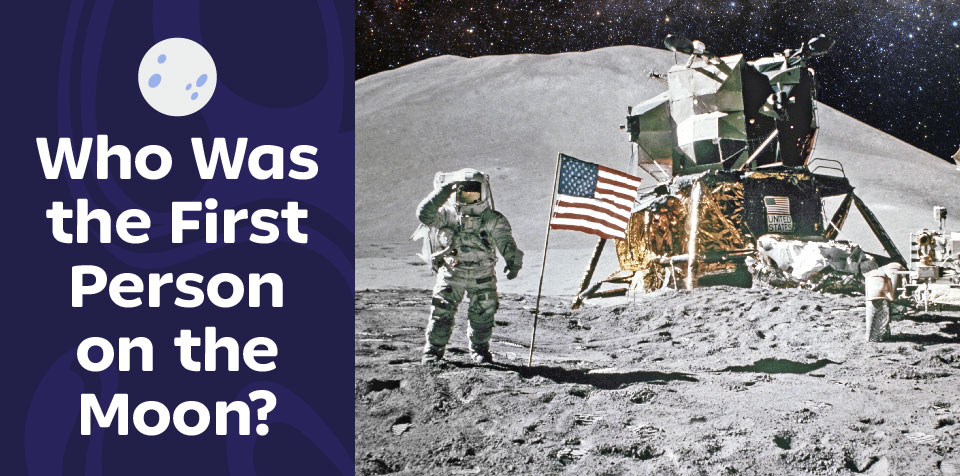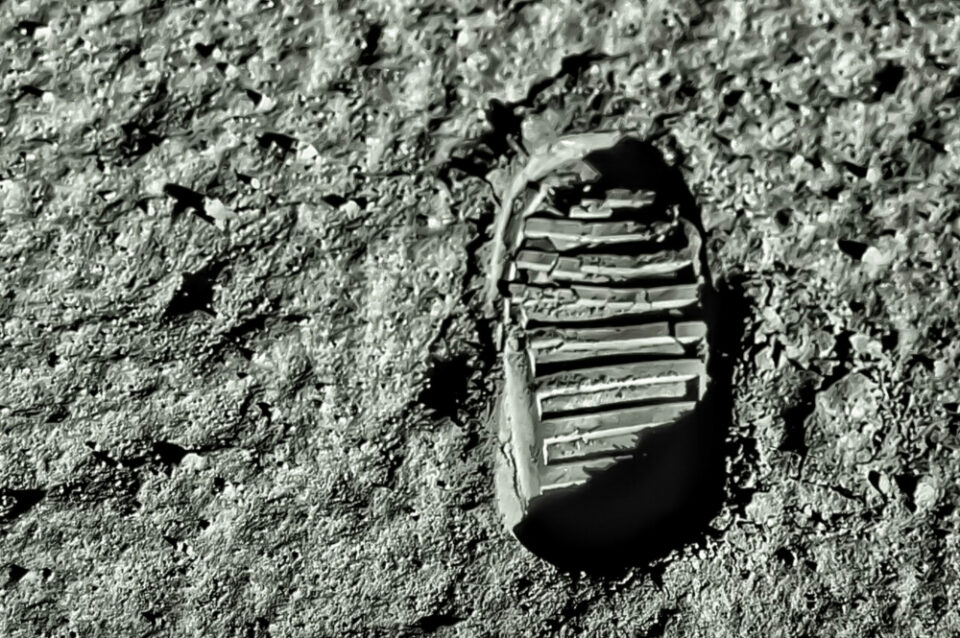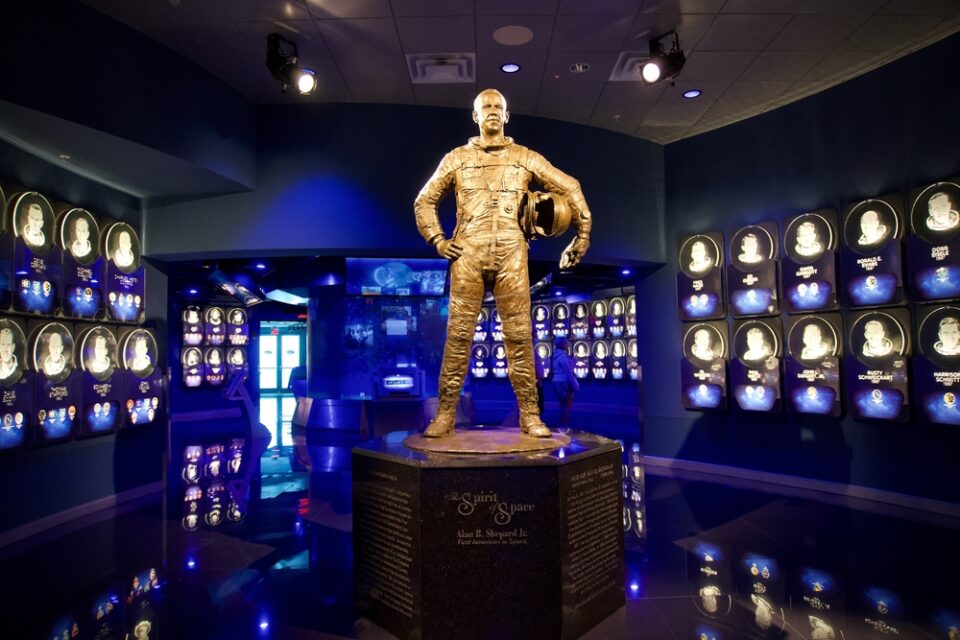
Learn about the First Person to Walk on the Moon
The night sky above us is far less mysterious than it used to be. Today, we know a lot about our galaxy. It’s quiet, cold, and filled with stars, planets, moons, and other celestial bodies. Humankind owes our understanding of space to brilliant scientists and brave explorers who ventured where no one had gone before.
Many astronauts have journeyed outside our atmosphere, but only a few have gone as far as the Moon. Round up your astronauts-to-be and teach them all about the early days of space exploration, starting with Neil Armstrong, who was the first person on the Moon.

Footsteps that Made History
Historians refer to 1955–1975 as “the Space Race.” During those years, the United States competed with the Soviet Union to make the most significant strides in space exploration. One of the most significant moments of the Space Race took place on July 20, 1969—the day a human being first walked on the Moon.
The journey to the Moon began on July 16 at 9:32 a.m. EDT, when the American Apollo 11 spacecraft launched from the Kennedy Space Center in Florida. On board were three astronauts: Michael Collins, Edwin “Buzz” Aldrin, and Neil Armstrong. After four days and over 200,000 miles (over 300,000 kilometers), Apollo 11’s lunar module, Eagle, touched down on the Moon’s surface.
Armstrong was the first to exit, making him the first person to walk on the Moon. Over 600 million people around the world watched on TV as he climbed down Eagle’s ladder and stepped onto the lunar surface, saying the now-famous words: “That’s one small step for man, one giant leap for mankind.”(Fun fact: Armstrong told people years later that he said, “One small step for a man,” but the radio transmission didn’t pick up the a!) Aldrin soon joined Armstong on the Moon’s surface, and together they explored for two hours and 36 minutes. They conducted experiments, collected Moon rock samples, and planted an American flag.
The Apollo 11 crew returned to Earth on July 24, 1969. They spent only eight days in space, but the mission was incredibly scientifically and culturally impactful. Apollo 11 sparked great pride in the U.S. space program and gave the world valuable information about the Moon’s composition. NASA scientists also invented several technologies for the Apollo missions that we still use today, such as freeze-dried food and memory foam. Most importantly, Armstrong, Aldrin, and Collins inspired people worldwide to push the boundaries of science and exploration.

Alan Shepard, the First American in Space
The Apollo 11 astronauts were the first to land on the Moon, but Alan Shepard paved the way by becoming the first American in space several years earlier on May 5, 1961.
Alan Shepard’s first journey into space occurred on a single-person capsule called the Freedom 7. The ship flew 116 miles (187 kilometers) high, then landed back on Earth successfully.
Scientists commonly consider “outer space” anything above the Kármán Line, an imaginary boundary 62 miles above the average sea level where the atmosphere becomes too thin to lift aircraft. NASA uses a boundary 12 miles (19 kilometers) below the Kármán Line, but by either measurement, Shepard traveled well into space.
Shepard’s historic flight only lasted 15.5 minutes, but it showed NASA that space travel was, in fact, safe for humans. Shepard later visited the Moon with the Apollo 14 crew in 1968, becoming the fifth American to walk on the Moon—and the first to hit a golf ball on the lunar surface.
Five Other Famous Astronauts
Shepard, Armstrong, and Aldrin may be some of the most well-known astronauts in the U.S., but they are just three of the many amazing Americans who have helped the world explore outer space. Here are five more influential astronauts you should know about.
John Glenn
John Glenn already had an impressive record when he joined NASA—he set a speed record as an airplane test pilot in 1957 when he flew from Los Angeles to New York in under 3.5 hours. But in 1962, Glenn became the first American to orbit Earth. His spacecraft, Friendship 7, circled the planet three times over five hours.
Sally Ride
NASA didn’t allow women in the astronaut program until 1977—but when they did, Sally Ride was one of the first in line. The ride was one of six female astronauts selected to join NASA’s space program in 1978. Five years later, she became the first American woman in space. Ride deployed two communication satellites during the 1983 STS-7 mission, during which she spent six days in Earth’s orbit.
Guion Bluford
About two months after Sally Ride broke barriers for women in space, astronaut Guion Bluford became the first African American in space. Bluford was a mission specialist for the STS-8 mission, which deployed a communication satellite from Earth’s orbit. Guion was a specialist on four space flights during his career.
Eugene Cernan
NASA’s Apollo astronauts visited the Moon for the final time in 1972. Eugene Cernan was the commander of that mission (Apollo 17), where he became the last person to walk on the Moon. Cernan and his crew collected about 250 pounds (115 kilograms) of Moon rocks to study back on Earth, but Cernan is best known for writing his daughter Tracy’s initials (TDC) in the lunar dust.
Peggy Whitson
When Armstrong stepped onto the Moon, Peggy Whitson was nine years old. She watched the Apollo 11 crew take those first historic steps, inspiring her dream of becoming an astronaut. That dream came true in 1996 when she was selected to train for NASA’s astronaut program.
Whitson first went to space in 2002 on a six-month mission to the International Space Station (ISS). That mission was the first of many. Today, Whitson holds the American record for the most total days in space (655 days, 22 hours, and 22 minutes).
Animals Go to Space Too
More than 600 humans have been to outer space, but space travel isn’t just a human achievement! Scientists have sent many living things into orbit, including the following critters:
- The first “animals” in space were insects: fruit flies! NASA sent the flies 68 miles (109 kilometers) into the air in 1947 to test how radiation would affect living beings in space.
- A total of 32 monkeys have flown to space, starting with a rhesus monkey named Albert II. His rocket, launched by NASA, passed the Kármán Line and reached 83 miles (143 kilometers) above sea level in 1949, 20 years before Armstrong landed on the Moon.
- The French space program sent a cat named Félicette into space in 1963. She experienced five minutes of weightlessness before landing on Earth safely (presumably on her feet).
- Two common-cross spiders named Arabella and Anita joined astronauts on a mission in 1973. NASA wanted to test whether spiders could spin webs outside Earth’s atmosphere—and the sister spiders proved it was possible.
These animal travelers made it much easier for NASA and other organizations to solve the problems of safe spaceflight. Their journeys allowed scientists to study how gravitational changes, radiation, and other factors affect living creatures.

